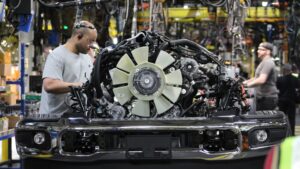The Complex Reality of "Made in America": Insights from Extreme Investor Network
In the realm of American automotive manufacturing, the phrase "Made in America" is more intricate than one might assume. Take the 2025 Ford Expedition, for example. As it rolls out from Ford’s Kentucky Truck Plant, this sleek SUV boasts an appealing bronze exterior trim and represents thousands of hours of American labor. However, the broader implications of its components reveal a much more globalized operation.
A Look Under the Hood: The Global Supply Chain
Despite being assembled on American soil, over 58% of the Expedition’s parts, including its signature 3.5-liter twin-turbocharged V-6 EcoBoost engine, hail from outside the U.S., with 22% sourced from neighboring Mexico. This disconnect highlights a pivotal truth: even as the American workforce contributes to the assembly of these vehicles, the underlying components often originate from numerous countries.
Ford’s CEO, Jim Farley, recently noted that “if every Ford is $50,000, we’re not going to win as a company." This sentiment underscores the balancing act automakers face: managing costs while satisfying consumer demand.
Pressures from Tariffs and Localization Efforts
The backdrop of these challenges is shaped by tariffs and localization efforts fostered under the Trump administration. A 25% tariff on imported vehicles forced manufacturers to reconsider their sourcing strategies, compelling them to invest heavily in U.S.-based operations. Yet, as industry experts point out, returning to a truly "American-made" model may not be practical.
“Some parts will still be cheaper to manufacture overseas, and even with tariffs, we must tread carefully,” warns Martin French, a veteran industry executive. The daunting reality is that vital materials such as steel, aluminum, and semiconductor chips are often not produced domestically at the necessary scale.
The Cost of Going Fully American
Ramping up domestic production could inflate vehicle prices significantly. Estimates suggest that sourcing components solely from the U.S. and Canada could add $7,000 or more to the price of vehicles, pushing many consumers to reconsider their purchases. It’s a challenging prospect for an industry where the average transaction price is hovering around $48,000.
Experts estimate that while aiming for a 75% U.S.-Canadian content standard might be feasible, achieving 100% presents an uphill battle fraught with escalating costs and time delays. Achieving this ambitious goal could take 10 to 15 years and upwards of $100 billion.
Realistic Alternatives
While the notion of completely American-made vehicles may fluctuate in the media, a target of achieving a higher percentage of domestic content is more within reach. Some automakers have vehicles that meet or exceed the 75% U.S.-Canadian parts threshold, but the journey toward that goal requires considerable investments and innovation.
For instance, recent reports highlight vehicles like the Kia EV6 and certain Tesla Model 3s that score highly on the American-Made Index. These models are evidence that while the journey toward more localization is ongoing, it’s already being met with some success.
The Road Ahead: Sustainability and Innovation
As consumer interest shifts toward sustainable practices, automakers are adapting not just to keep up but to lead the way. With an increasing focus on electric vehicles and new manufacturing processes, firms can juggle the dual pressures of localization and global sourcing. Automation and innovative technologies may pave the way for reducing costs and increasing efficiency, making the dream of high domestic content more attainable.
At Extreme Investor Network, we believe that understanding the complexities of vehicle production can empower consumers and investors alike. As the automotive landscape continues to evolve, staying informed about these metrics will be crucial. The interplay between globalization and local manufacturing not only impacts the automotive industry but serves as a bellwether for broader economic trends.
As we navigate this intricate web, it’s clear that the path to a more sustainable, domestically-focused automotive industry is neither straightforward nor without its challenges. However, it does present opportunities for growth, innovation, and ultimately, making informed choices as consumers and investors. Stay connected with us for more insights and analysis in the ever-evolving world of business and investment.

